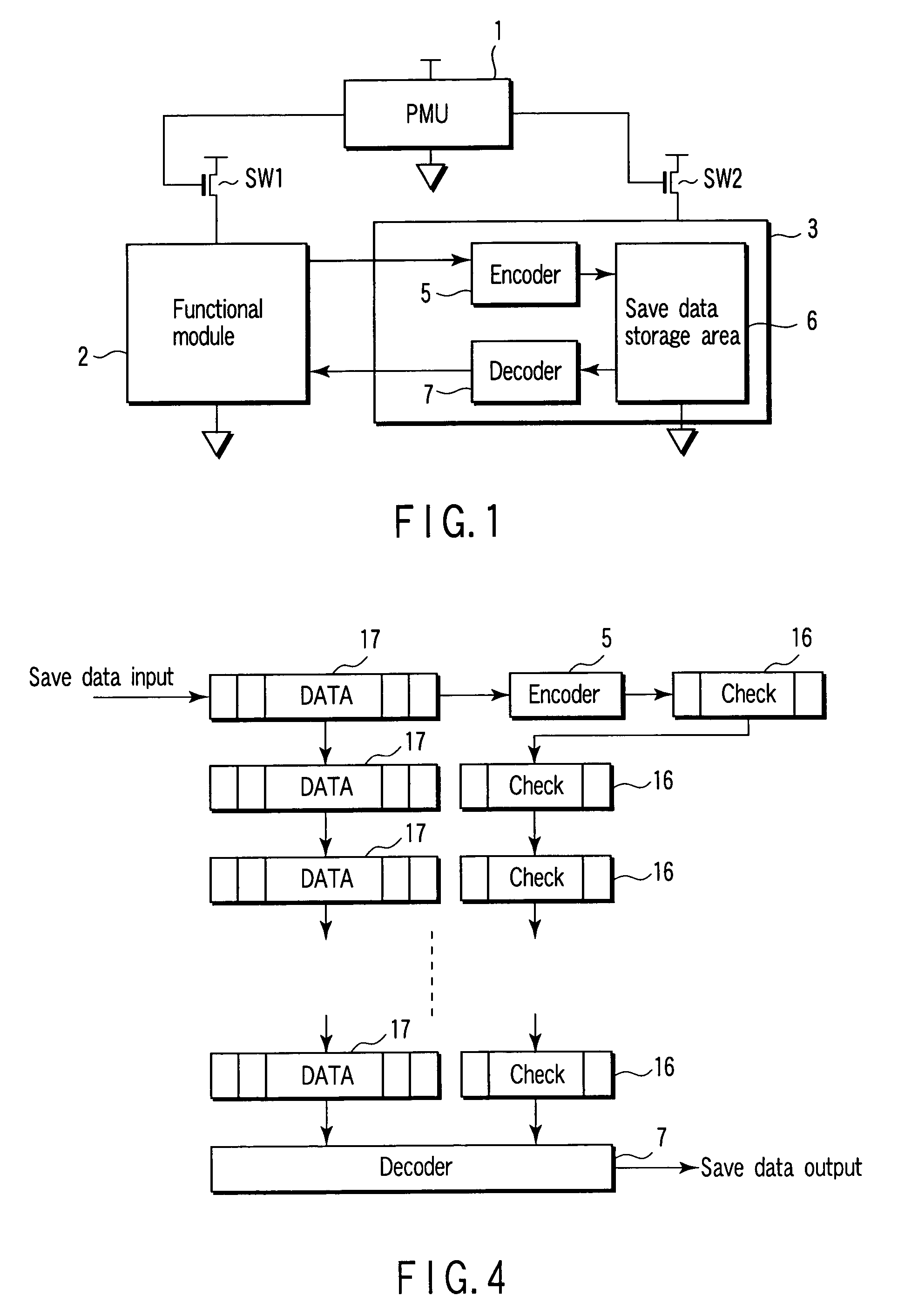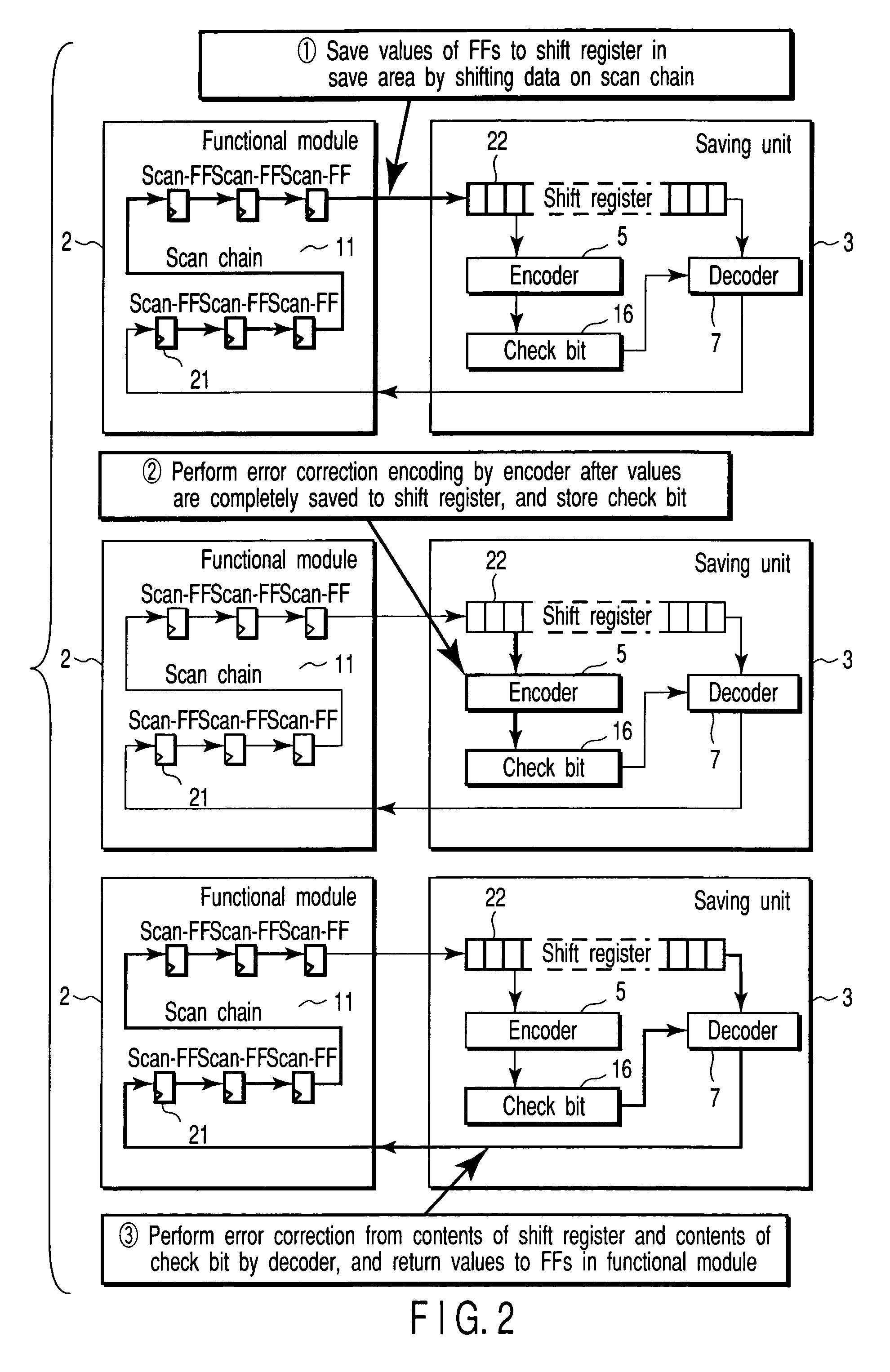Power management for circuits with inactive state data save and restore scan chain
a technology of power management and scan chain, applied in the field of integrated circuit devices, can solve the problems of inability to prevent power loss by leakage current, loss of all information held in a circuit, and inability to secure a storage area
- Summary
- Abstract
- Description
- Claims
- Application Information
AI Technical Summary
Benefits of technology
Problems solved by technology
Method used
Image
Examples
first embodiment
[0054]FIG. 5 is a block diagram showing the first embodiment of the integrated circuit device according to the present invention. The first embodiment is a more practical arrangement of the configuration shown in FIG. 1. As in the configuration shown in FIG. 1, a PMU 1 is the main component for managing power supply control and control of a saving process itself. The PMU 1 is usually installed in an integrated circuit device (LSI) aiming at low power consumption. The PMU 1 controls clock supply and power supply to functional modules 2, thereby minimizing the power consumption in a functional module 2 in an idling state. The PMU 1 can be implemented by software such as an OS (Operating System) or hardware. In either case, the PMU 1 controls clock supply and power supply to a specific functional module on the basis of the process history and waiting time in the integrated circuit device.
[0055]A plurality of functional modules 2 are managed by the PMU 1. The PMU 1 can select any functi...
second embodiment
[0076]FIG. 7 is a block diagram showing the arrangement of a scan controller according to the second embodiment. A scan controller 10 of this embodiment includes a saving controller 30 which outputs enable signals (SH_EN_A and SH_EN_B) of a saving unit 3. The saving controller 30, not a PMU 1, is the main component of saving or restoration control. This is the difference from the configuration of the first embodiment described above.
[0077]Similar to that of the first embodiment, the scan controller 10 of this embodiment also switches the whole integrated circuit device to a scan test mode in a normal operation. When data saving or restoration by a shift operation using a scan chain 11 is to be performed, the saving controller 30 receives an instruction indicating this information from the PMU 1. In accordance with the instruction, the saving controller 30 selects a corresponding functional module and outputs the enable signal (SH_EN_A or SH_EN_B). Also, the saving controller 30 outp...
third embodiment
[0083]FIG. 9 is a block diagram showing the third embodiment (data is saved to a dedicated area) of the integrated circuit device according to the present invention.
[0084]Reference numeral 20 in FIG. 9 denotes a memory as a functional module. A module A for writing and reading out data in and from the memory 20 includes an address generator 23 which generates an address for accessing the memory 20.
[0085]A saving unit 3 has a save data storage area 6 as a dedicated area different from the memory 20 as a functional module. The saving unit 3 can be formed in each module or for a plurality of functional modules. If the capacity of the save data storage area 6 can be increased, a correction encoding process may be made unnecessary by the use of the majority method or the like. In this case, a serial-to-parallel converter and encoder 14 and a decoder and parallel-to-serial converter 15 can be omitted. An embodiment using the majority method will be explained later (the sixth embodiment).
[...
PUM
 Login to View More
Login to View More Abstract
Description
Claims
Application Information
 Login to View More
Login to View More - R&D
- Intellectual Property
- Life Sciences
- Materials
- Tech Scout
- Unparalleled Data Quality
- Higher Quality Content
- 60% Fewer Hallucinations
Browse by: Latest US Patents, China's latest patents, Technical Efficacy Thesaurus, Application Domain, Technology Topic, Popular Technical Reports.
© 2025 PatSnap. All rights reserved.Legal|Privacy policy|Modern Slavery Act Transparency Statement|Sitemap|About US| Contact US: help@patsnap.com



